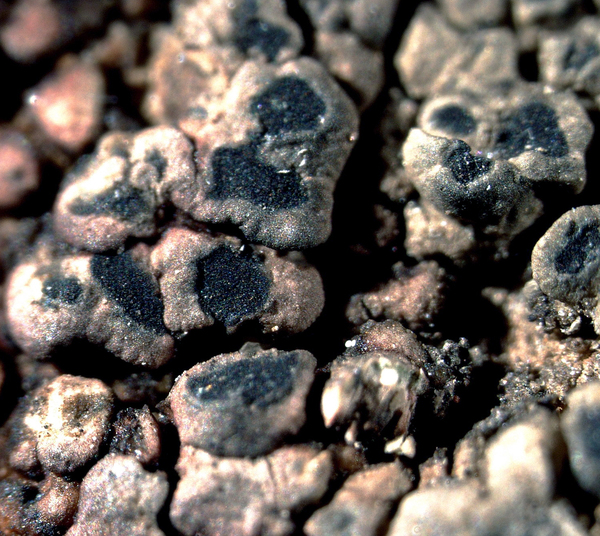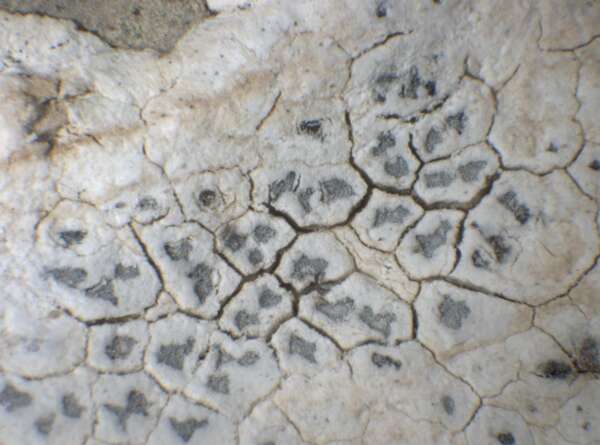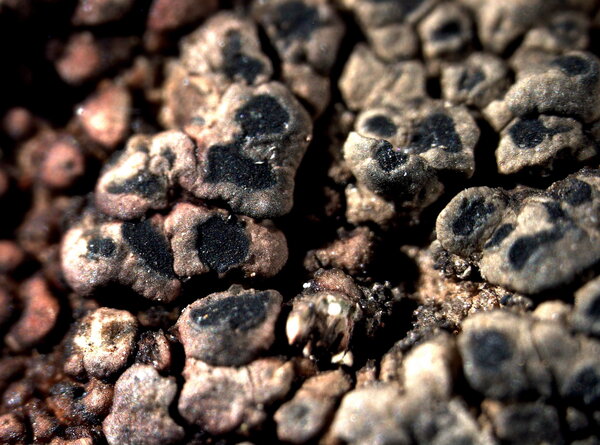Aspicilia polychroma Anzi
Cat. Lich. Sondr.: 59, 1860.
Synonyms: Aspicilia polychroma subsp. hypertrophica Asta & Cl. Roux?; Aspicilia polychroma var. ochracea Anzi?; Lecanora polychroma (Anzi) Nyl.
Description: Thallus crustose, episubstratic, areolate-verrucose, pale greyish white, yellowish white or dark brownish grey, forming > 5 cm wide, more or less orbicular patches, usually thinner in marginal parts, often delimited by a black prothallus. Areoles contiguous, 0.1-1(-2) mm wide, to 0.8 mm thick, the sterile ones flat, the fertile ones convex, the peripheral ones often elongate, giving the thallus an almost placodioid appearance. Apothecia lecanorine-aspicilioid, immersed in the areoles (1-3 per areole), irregular in outline and sometimes confluent, (0.1-)0.3-0.8 mm across, with a black but more or less densely white-pruinose, concave to flat disc, and a thick, raised thalline margin. Epithecium brownish green to olive, N+ emerald green; hymenium colourless, 85-110 µm high, I+ blue or I-; paraphyses c. 1.5 µm thick at mid-level, the apical cells to 5 µm wide; hypothecium colourless, c. 50 µm high, not underlain by an algal layer. Asci 8-spored, clavate, the thin outer coat K/I+ blue, the wall and apical dome K/I-. Ascospores 1-celled, hyaline ellipsoid, 13-18 x 8-10 µm. Pycnidia immersed, elongated, brown in upper part, with a colourless wall. Conidia thread-like, straight, 20-25 x 0.5-1 µm. Spot tests: cortex and/or medulla K- or K+ yellow, C-, KC-, P- or P+ yellow-orange. Chemistry: with variable amounts of substictic acid (from traces to major).
Growth form: Crustose
Substrata: rocks
Photobiont: green algae other than Trentepohlia
Reproductive strategy: mainly sexual
Poorly known taxon in need of further study
Commonnes-rarity: (info)
Alpine belt: rather rare
Subalpine belt: rare
Montane belt: extremely rare
Dry submediterranean belt: absent
Humid submediterranean belt: absent
Padanian area: absent
pH of the substrata:
1 2 3 4 5
Solar irradiation:
1 2 3 4 5
Aridity:
1 2 3 4 5
Eutrophication:
1 2 3 4 5
Poleotolerance:
0 1 2 3
Altitudinal distribution:
1 2 3 4 5 6
Rarity
absent
extremely rare
very rare
rare
rather rare
rather common
common
very common
extremely common
Loading data...
Occurrence data
Predictive map
Growth form: Crustose
Substrata: rocks
Photobiont: green algae other than Trentepohlia
Reproductive strategy: mainly sexual
Poorly known taxon in need of further study
Commonnes-rarity: (info)
Alpine belt: rather rare
Subalpine belt: rare
Montane belt: extremely rare
Dry submediterranean belt: absent
Humid submediterranean belt: absent
Padanian area: absent
pH of the substrata:
| 1 | 2 | 3 | 4 | 5 |
Solar irradiation:
| 1 | 2 | 3 | 4 | 5 |
Aridity:
| 1 | 2 | 3 | 4 | 5 |
Eutrophication:
| 1 | 2 | 3 | 4 | 5 |
Poleotolerance:
| 0 | 1 | 2 | 3 |
Altitudinal distribution:
| 1 | 2 | 3 | 4 | 5 | 6 |
Rarity
absent
extremely rare
very rare
rare
rather rare
rather common
common
very common
extremely common
Loading data...
Occurrence data
Predictive map









